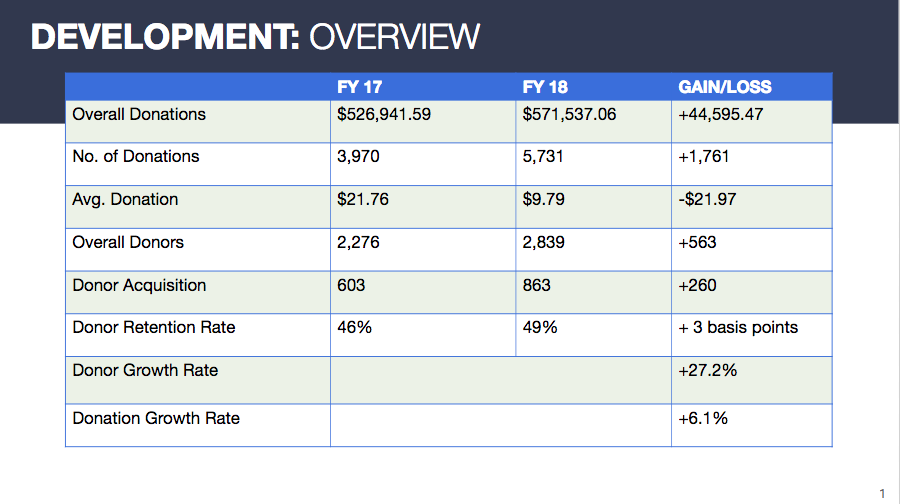Click here to download the free template: https://hubs.ly/H0dnBZX0
Can you believe it? Another year has nearly come and gone. In lieu of the inevitable flood of content on #GivingTuesday and end of year fundraising, I thought I would get a head start on another important year-end item; reporting to the board.
Depending on your organization’s fiscal calendar, your year end may have already occurred. But, if your organization runs on the calendar year, this means it’s nearly time to share an update with your the board. Reporting to the board may be daunting, but it’s incredibly important. Your board is tasked with overseeing your organization, and providing them with a snapshot into the health of the organization’s fundraising is critical to their success.
The goal of a board meeting goes beyond simply discussing and voting on the affairs of the organization. Board members typically assume their positions because they are interested in the wellbeing and health of the organization. As a development professional it’s your responsibility to share with the board enough relevant and pertinent information to help them make sound decisions into the future. Your annual (or hopefully more frequent) meeting with the board is an opportunity to share what you think is most helpful to allow the organization to further its mission.
It is not uncommon for board members to be disinterested in fundraising. The mission of the organization and the programs it funds may be of primary interest to all (or most) of the board. That’s fine, it simply means it’s even more important that we do a good job “peeling back the curtain” when it comes to the financial health of the organization. It’s important to remember there are no programs without fundraising. Your brief presentation to the board is a great opportunity to make it clear how important your role is to the organization and why the board should take an interest.
What not to include in your presentation
- Advanced metrics. There’s no need to include things like donor lifetime value, donor acquisition cost, or trends in recaptured donors. The board will lose interest quickly if the concepts you are discussing aren’t simple and crystal clear. Since you most likely will not have a lot of time to share your presentation it is advised to avoid these more complex metrics. Have conversations with your team on these topics instead.
- Predictive analytics. Don’t dedicate a slide or two to discuss the results of your wealth screening or other predictive modeling efforts. Why? Because board members are more interested in the facts, and predictive tools (no matter how helpful we find them), aren’t “true” until we confirm them. Also, your board members were probably screened during the wealth append, and it may open a can of worms discussing with them your techniques to identify major donors.
- All your successes. It would be wonderful if your entire presentation was simply a running list of successes from the past year, but I’d advise against it. You have limited time to present to your leadership, and focusing on a few key points is recommended. If that means you cannot talk about each and every “win” you and your team experienced over the course of the year, so be it. It’s worthwhile for you and your leadership to focus in on what is most important.
What is most important to share with your board
Give your board an overview of this year’s fundraising performance. To do that, create a slide in your presentation that has a table with:
- Total dollars raised
- Total number of donations
- Average donation amount
- Total donors
- Acquired donors
- Donor retention rate
- Donor growth rate
- Donation growth rate
That’s it, pretty simple. The overview should be enough information to convey to your board the success you’ve had during the year. Be sure to include last year’s numbers and the percent change in your presentation to provide context for this year’s performance. Reference the template to see what I mean.
It’s also advisable to include a chart of graph of these key metrics. For example, show the year over year growth in a bar chart. That’s easy enough with Fundraising Report Card.
Next, it’s important to provide a breakdown of where the funding has come from. In this section of the report simply list out all of the fundraising initiatives you’ve conducted during the year and show the total dollars raised this year and last year. For example you’ll have a section for “Events,” and another for “Bequests,” so on and so forth. This section of your presentation exists to help leadership grasp where your experiencing fundraising growth and where things may be a bit more stagnant. Again, reference the template to see what I mean.
The final piece of information you should include in your board presentation is a section on donor relations. What efforts, projects, and initiatives have you taken on during the past year to build better relationships with your existing base?
This is your time to shine. Talk about the things your team did to make donors feel special. Discuss the success you had a with a new vendor. Treat this section of the presentation as a “show and tell.” Give your board some insight into the great success you and your team have been having this year. But don’t overdo it, 5 bullet points is plenty.
Applying this at your shop
Download this template for your board meeting presentation. Fill it out with the information we discussed above, and fold it into your existing deck. Use Fundraising Report Card to calculate your metrics (nearly every metric we discussed above is part of the Free Fundraising Report Card), and use graphs and charts were appropriate.
When you’ve completed your presentation, email it to me! It never hurts to have a second set of eyes on a powerpoint before you present it. My email is zshefska at imarketsmart.com.
Good luck!







This is an interesting take on the report to the board. While I agree on some of the points, I think there are some “out of the box” sections of a board report that can be really great, too! Things like telling the board the 1-2 items they’ll be asked to vote on, posing a question to ponder before the meeting, etc. I couldn’t find a great template to give my clients so I made one! If any of your readers are interested in checking it out, it can be found at: oneninedesign.net/shop/board-report